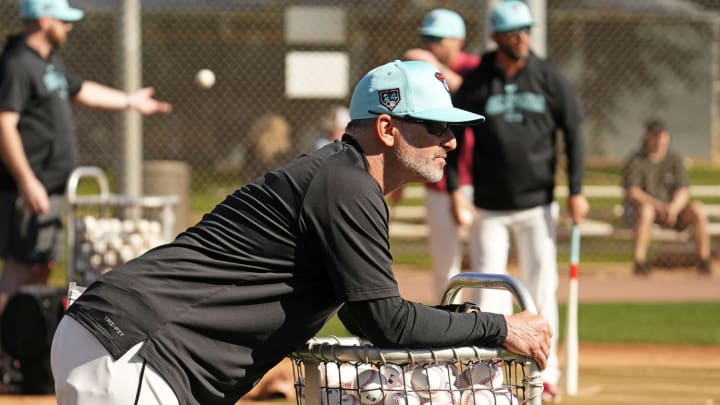How Much Do the Diamondbacks Weight Spring Results?

In this story:
The Diamondbacks, like most teams, have multiple Opening Day roster spots up for grabs in Spring Training and must make accurate evaluations to have the best chance to get the season off to a good start. These evaluations can be difficult, and go far beyond typical performance measures that most people refer to when trying to determine how a player is performing.
Where they land on some of the most difficult decisions may not be immediately apparent just from looking at the box scores and team stat pages. The manager was willing to give us a look Inside the Diamondbacks' thought process, which is all we can ask.
When looking at things like earned run average, batting average, or OPS in spring, it can be very misleading. Sample sizes are small, and the players are just rounding into shape and working on various aspects of their game that aren't necessarily conducive to producing good performance numbers. Speaking with D-backs Manager Torey Lovullo, he was able to give a better sense of the things that they're looking at. They don't completely ignore the results, but their evaluations go much deeper.
"We take notice of the guys that have a zero earned run average of course," Lovullo said. "It means things are working very well and they're getting a lot of outs. But we look at the part of the lineup, the time of the game that they're pitching in, bake that in, and then maybe look at the stuff. In particular with starting pitchers, they're probably going to be getting the best part of every lineup, every single time, so that's an easy evaluation. So we want to keep it all relative."
The quality of contact being given up is something the coaches are looking at closely, and which may not be readily apparent to most fans during spring training. Statcast data is limited, and only a few games are broadcast. But Lovullo made clear the team has their finger on the pulse of the true underlying quality of contact that is happening.
"We start to look at the type of contact, whether it's quality contact or weak contact, and still evaluate the stuff in the zone. Is it a ball that dribbles through the infield versus a line drive at somebody? We weigh that all in."
That's not to say that the team isn't subject sometimes to looking at the results and performance metrics more than they should. Lovullo acknowledged just how tough that challenge can be. He even relayed a situation from a few years ago. "There was a right-handed reliever who basically had a zero earned run average, and his agent was really barking at us to have him make the team and he did not make the team."
"It's always a tough challenge for us to not weight the spring training numbers too heavily and to evaluate what we're seeing from inside of the game rather than the results...... You can be misled a little bit, you have to be very careful with it. Sometimes there are guys we'll say look the stuff and the activity we've been watching has been very good and it's spitting out positive results. We'll add it in but it's not the most important thing"
It's much the same on the hitting side of the equation. While a lofty spring training batting average is nice, the team is diving much deeper than that to make their decisions. Lovullo continued to explain.
"The hitting portion of it for me is are they in the middle of the diamond, are they back spinning the baseball, what's their front side look like. Are they hitting off their front side, are they able to hit secondary stuff."
It's the ability to recognize and hit breaking and off-speed pitches that becomes the separator. During the first few days of camp, the hitters are perceived to be "ahead" of the pitchers. But that's because they are just getting their velocity up and getting a feel for their secondary stuff. Then the pitchers start to get that dialed and it becomes the hitters' turn to play catchup again. Lovullo tried to explain this dynamic.
"I said about three or four days ago that the hitters start to get caught up to the pitching because they can identify breaking balls. Not necessarily square them up, but that's what I'm looking for now. How are you getting to the breaking ball, how are you seeing it, are you swinging at good ones."
Ultimately the team is charting and paying close attention to how the ball is being hit, not just the batting averages.
"There's a lot that goes into quality contact," Lovullo said. "It's not by accident. I like a hard line drive in the middle of the diamond whether it's caught or not, more than a ground ball that gets rolled over and through the six-hole or the four-hole. I want to see a back-spun ball with a good balanced approach."
The ultimate roster decisions are made by the front office and General Manager Mike Hazen. But during this critical phase of preparation for the season, he is leaning heavily on his Manager and the coaching staff to make the proper evaluations.
Handicapping the Diamondbacks Opening Day Roster

Jack Sommers is a credentialed beat writer for Arizona Diamondbacks ON SI. He's also the co-host of the Snakes Territory Podcast and Youtube channel. Formerly a baseball operations department analyst for the D-backs, Jack also covered the team for MLB.com, The Associated Press, and SB Nation. Follow Jack on Twitter @shoewizard59
Follow shoewizard59